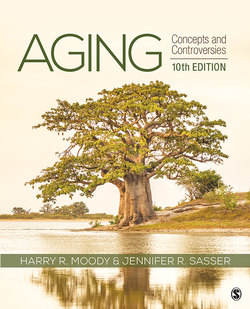Читать книгу Aging - Harry R. Moody - Страница 87
На сайте Литреса книга снята с продажи.
Focus on Practice
ОглавлениеHealth Promotion
Can we take steps now to control our own longevity? The consumer market for “antiaging” products is growing. Magazines on the subject can be found on every newsstand. But most claims for life-extending products are not proved by science. For example, melatonin, antioxidants, human growth hormone, and DHEA have all been hailed as antiaging breakthroughs, but proof has not lived up to the promise (Weintraub, 2010). There are no diets, hormone injections, or vitamin or mineral supplements that have so far been proven to slow down the process of aging (Butler et al., 2002). However, it is possible that a breakthrough in our knowledge of the biology of aging could give us ways to slow down aging in the 21st century.
When we think about the prospect of slowing the process of aging or dramatically extending maximum life span, many questions present themselves. Would people really want to triple their life spans? Would they want to hold the same job or be married to the same person for 150 years? What would society be like if people lived for centuries instead of decades (Post & Binstock, 2004)?
These questions are still in the realm of science fiction, but many interventions already have been shown to promote health and longevity in ways that can benefit people today (Haber, 2016). For example, the death rate from cardiovascular disease has been cut in half in the past two decades chiefly because of a reduction in high-risk behaviors such as smoking. Changes in diet or exercise patterns could provide further gains in adult life expectancy.
The secrets to keeping the effects of aging at bay are actually well known (Brody, 2001). Most of the causes of lost years of life today are related to lifestyle choices: alcohol, tobacco, exercise, and diet (Arking, 1991). Herbert de Vries, a highly regarded exercise physiologist from the University of Southern California, has estimated that regular exercise could give a huge boost to the life expectancy of most people. Millions of Americans have already started eating a low-fat, high-fiber diet, just as they have given up smoking. Others go even further and seek to minimize free radical damage to cells by including more antioxidant carotenes in their diets (Walford, 1986).
The topic of health promotion and aging engenders a familiar argument between optimists and pessimists. On the one hand, Hayflick argues that calorie-restricted, long-living mice are merely living out their fixed natural life spans. In the end, our genetic program prevails, and environmental interventions, such as diet, can accomplish only a limited amount. If Hayflick is right, then Walford (1986), like Juan Ponce de León, has embarked on a vain search for the fountain of youth.
But the optimists hold a different view. According to one scenario for the future, as a result of prudent nutrition and more exercise, the average life span could well rise from 76 to beyond 80 years during the 21st century. Then, early in the next century, through hormone replacement and genetic engineering, the maximum life span could push well beyond the current limit of 120 years. Optimists believe that lifestyle enhancement and new technologies could combine to delay or even reverse aging, thus extending youthfulness and pushing the limits of the life span itself (Hall, 2003).
Steps to improve longevity are already becoming part of popular culture. Changes in diet and exercise, reductions in smoking, and health-promotion activities of many kinds are now far more common than they were two decades ago.
In thinking about these scenarios for the future, we should retain a measure of skepticism. We should also focus on practical steps that are proven and feasible right now. Health promotion has to be based on science, not on conjecture, fear of frailty and mortality, or hopes for the future.
Health promotion seems clearly to be a desirable trend, but it also raises some difficult questions about personal and social responsibility (Centers for Disease Control and Prevention, 2003). What should we do about groups in our society who cannot or will not change their unhealthy behaviors? Are harmful behaviors ultimately a matter of free choice, or do environmental and social factors also shape behavior? The cost of Medicare depends a great deal on the cost of chronic illnesses. If we embrace an ethic of personal responsibility for health care, might we be less willing to support public funding for medical care? Should health promotion take into account inequality in income, education, and access to health care? How do we motivate people in favor of health promotion when the results of “bad choices”—such as smoking, poor diet, lack of exercise, or use of alcohol—don’t show up until decades later? These questions will remain both personal and societal issues for years to come.
